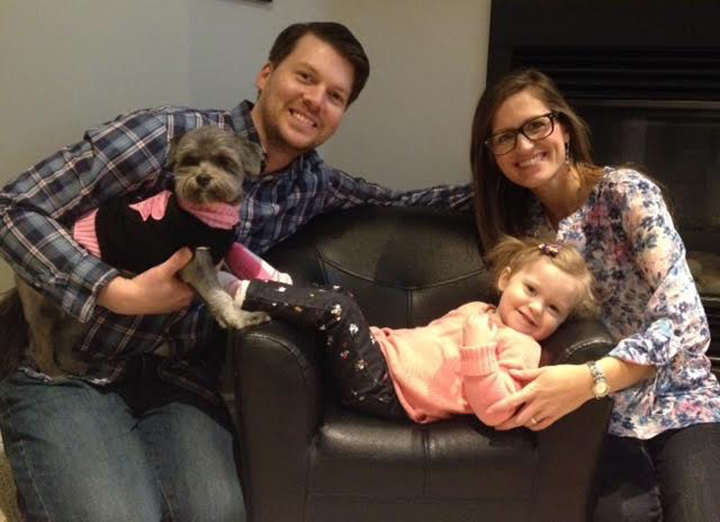BURLINGTON — After spending more than $30,000 on fertility treatments to grow their family, Taunya and Rob Johnston are relieved to participate in their first provincially funded in-vitro fertilization cycle.

“The financial help has been tremendous because we were coming from a place where we spent so much in trying to conceive Cece that we weren’t financially ready to move forward,” Taunya said.
“So the funding meant we could start now. This is something we could do.”
READ MORE: How to have a baby: Fertility clinic founders share 5 dos and don’ts
Cece, short for Cecelia, is their first child. She’s two years old and was conceived with the help of IVF. The Johnstons now hope to give their daughter a sibling.
Further complicating their journey, Taunya suffers from a chronic gastrointestinal disease called Diffuse Irritable Gastrointestinal Tract Syndrome. It’s meant an alternate route to parenthood is necessary. It’s also costly.
“A cycle of IVF is around $10,000 and embryo freezing is a little bit more,” said the Johnstons’ doctor, Dr. Ed Hughes of Burlington’s ONE Fertility clinic.
Hughes added that does not include the cost of medication, which can be thousands more.
He has been pushing for funding from the provincial government for years. In 1994, the province scaled back IVF funding to only cover women suffering from two blocked fallopian tubes.
READ MORE: When is the best age for women to have children? Study claims to have the answers
“IVF is the most effective treatment we have. And it’s great for couples who have bad sperm or blocked fallopian tubes,” said Hughes.
“But it’s also a good treatment for people who have tried for many years — two, three years — without success, so it can be used for a wide variety of couples.”
In December, the Ontario government rolled out its new $50 million fertility program. It funds unlimited cycles of artificial insemination for patients with a valid Ontario health card, and one cycle of in-vitro fertilization per patient per lifetime for those with a valid Ontario health card who are under 43 years of age.

Get weekly health news
“The program is open to patients with medical issues causing infertility, as well as, patients with non-medical forms of infertility, such as single people or same-sex couples,” according to a news release by the Ontario government.
Bottom line, the program gives access to at least 4,000 more in-vitro fertilization patients each year than were previously served under OHIP.
But six months in, it’s become clear there are pros and cons to the program.
“Sadly, the supply is far lower than the demand, the supply is less than what we have been doing privately and the demand has probably quadrupled or more,” said Hughes.
“Those who need IVF soon, particularly late 30s, early 40s, we are having to tell them we are sorry, but the waiting list is too long and maybe they won’t be able to access funded care.”
The Johnstons feel fortunate to have been chosen for a funded cycle, and as a result, they have five embryos — meaning five chances at pregnancy.
They’ve gone ahead and had one of those embryos implanted, and now they wait — two long weeks — hoping and praying a pregnancy will result.
READ MORE: Why funding in vitro fertilization treatments could save Alberta Health money
“It’s only two weeks, but it’s a gruelling two weeks where you’re over-analyzing every symptom and possibility and emotion,” said Taunya.
The result was positive.
“We found out pretty early that we had good news,” Rob said from their home in Cambridge, Ont. “Then we saw the heartbeat and that was really exciting.”
“We don’t usually do pregnancy tests but we did one early … and we we’re pregnant,” added Taunya, whose excitement quickly turned to despair.
After several days, the couple learned they’d miscarried.
“Ultimately we lost, so that was really challenging,” Taunya said through tears.
READ MORE: Ontario delays funding announcement for in-vitro fertilization treatment
This is the couple’s second loss, but as is the case with miscarriage, it is often unexplainable.
“It’s a biological process, it’s not engineering, it’s uncertain,” Hughes said about IVF.
Taunya and Rob have four more embryos, four more chances at a baby, and while they grieve the loss of this latest pregnancy, they have no plans to give up on the dream of a sibling for Cecelia.
“She is going to be a big sister, yup, one way or another, she’ll be a big sister,” said Rob.
The Johnstons are committed to expanding their family and would have embarked on the journey with or without funding from the provincial government. But they admit, the program has allowed them to breathe easier and focus on what’s important. Their goal of making a baby.
“We paid our credit card off with our actually money opposed to our line of credit that we did for years previously. So that was kind of nice … It’s really reassuring we aren’t continuously carrying on debt forward just to have a baby,” said Rob.
“We didn’t have that financial burden of worrying about where the money is going to come from for us to participate in the opportunity to create a family,” added Taunya.














Comments